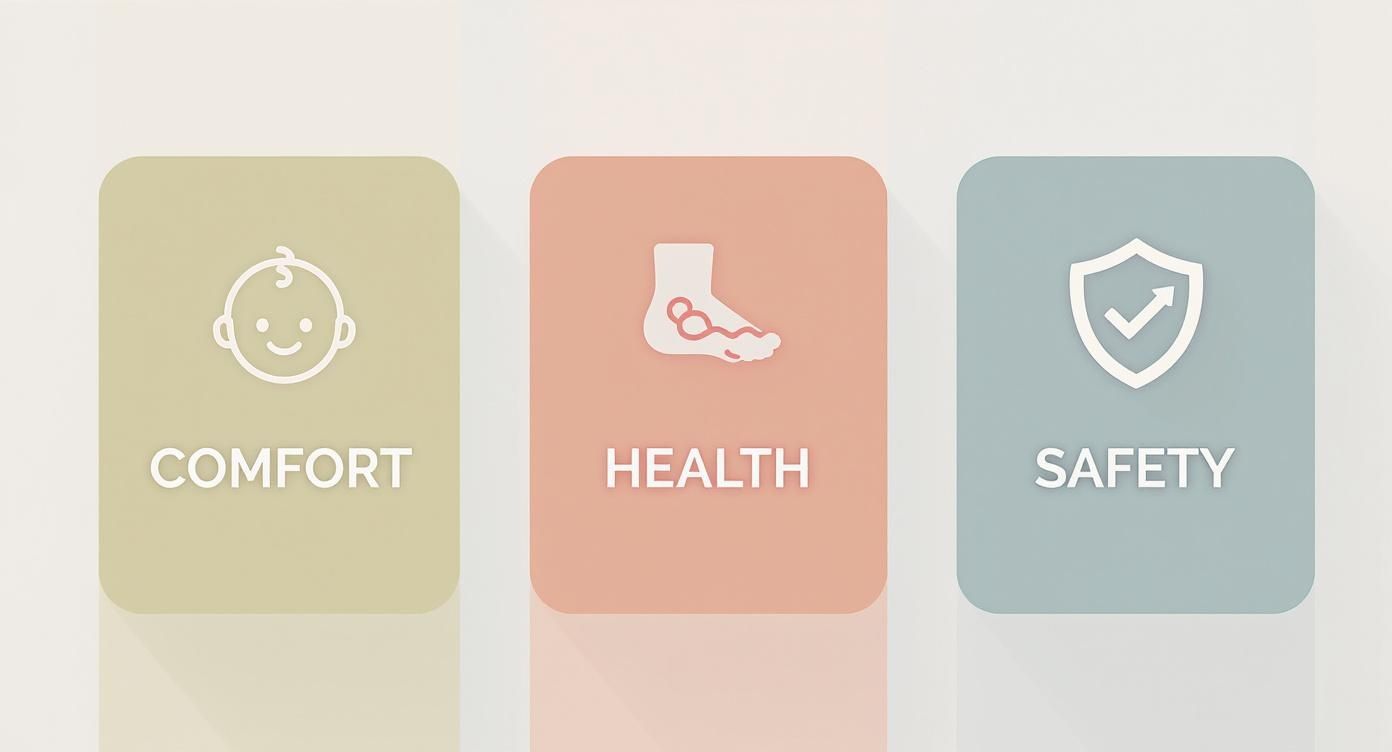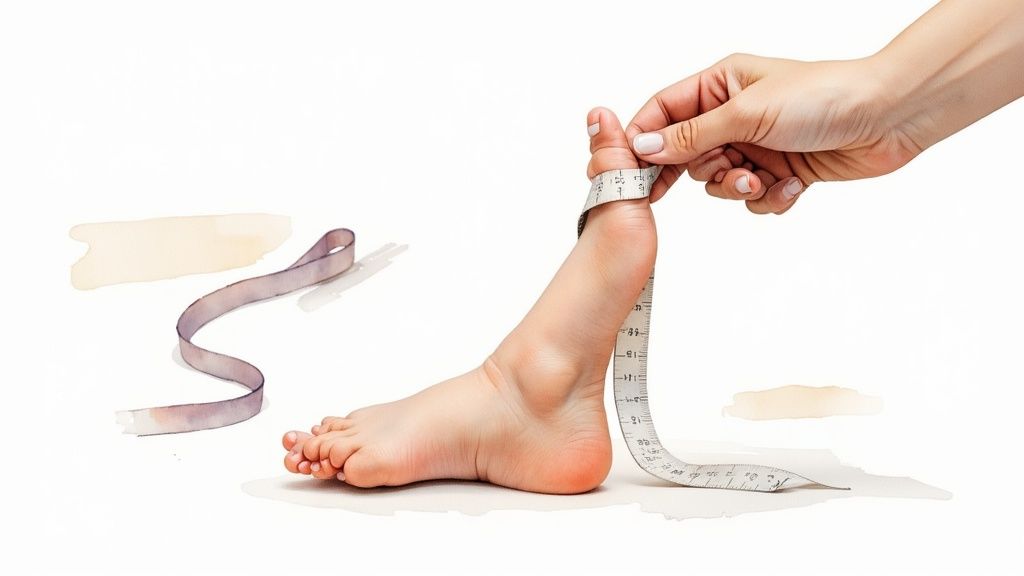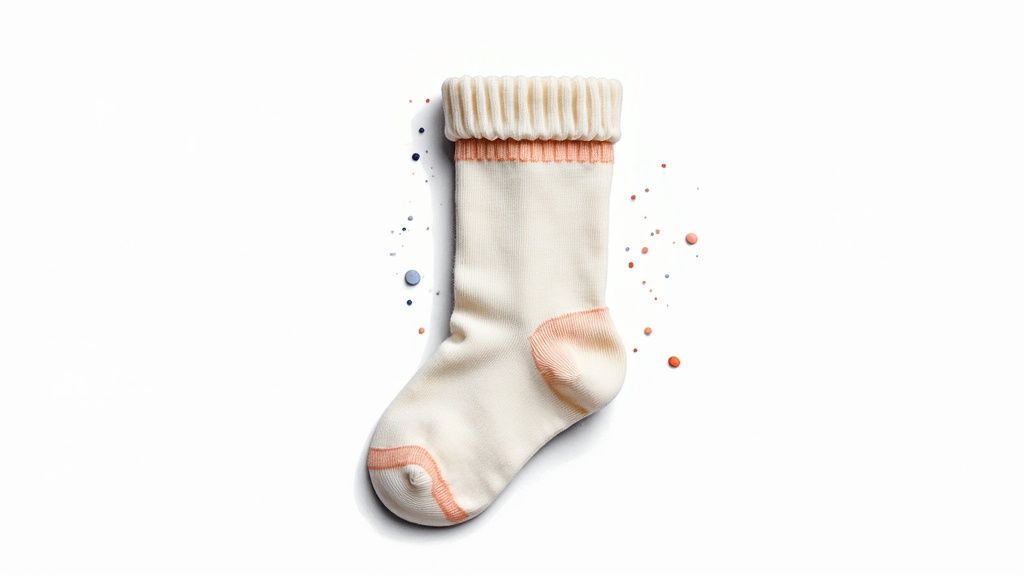Welcome to the beautiful, wild ride of parenthood! You’ve probably already discovered that something as simple as finding the right infant sock sizes can feel like you’re trying to crack a secret code. Why do some newborn socks slide right off those tiny feet, while others seem to squeeze their adorable, chubby ankles?
You're not alone in asking this! Finding that perfect fit is about so much more than just looking cute. It's about supporting your baby's healthy foot development and, most importantly, keeping your little one comfortable, safe, and happy. Let's walk through it together.
Why Getting the Right Sock Size Truly Matters
Navigating the world of baby clothes is a real adventure, and socks are a small but surprisingly important piece of the puzzle. It's easy to grab any tiny pair off the shelf, but the right fit plays a huge role in your baby’s daily well-being. Think of it less like an accessory and more like a foundational part of their wardrobe.
If a sock is too tight, it’s not just uncomfortable. It can leave little red marks on your baby’s delicate skin and—even worse—restrict circulation to their fast-growing feet. On the flip side, a sock that’s too loose is destined to be lost forever in a grocery store aisle, leaving those little toes cold.
Comfort, Health, and Safety
It all comes down to three key things for your baby:
- Healthy Foot Development: A baby's feet are incredibly soft and flexible. Socks that are too tight can bunch up their toes, getting in the way of natural movement and proper growth. You want them to have plenty of room to wiggle!
- Uninterrupted Circulation: A good sock has a gentle cuff that stays up without digging in. This keeps the blood flowing freely, ensuring their feet stay warm and healthy without causing any discomfort.
- Everyday Comfort and Happiness: Let’s be honest: a comfortable baby is a happy baby. A great-fitting sock made from soft, breathable fabric prevents skin irritation and keeps them content, whether they’re napping, kicking their legs, or just starting to explore the world.
The infant sock market has grown as more parents realize how vital safety and comfort are. This focus on proper fit is key for supporting a baby's unique foot growth patterns. You can explore more insights about the baby apparel industry and its shift toward what’s best for our little ones.
In the end, choosing the right sock is one of those small acts of care that makes a surprisingly big difference. It ensures your baby’s feet are protected, cozy, and free to grow, setting them up for happy feet right from the start.
The Ultimate Infant Sock Size Chart
Let’s be honest, figuring out baby sock sizes can feel like trying to solve a puzzle. You'd think it would be simple, but every brand seems a little different. That's why we put together this chart—think of it as your friendly, go-to cheat sheet.
Because every baby grows on their own unique schedule, just going by age can be a bit of a gamble. The real key to a perfect fit is knowing their actual foot length. We've laid it all out for you here, connecting age ranges with foot measurements (in both inches and centimeters) and the corresponding shoe sizes. No more guesswork.
Infant Sock Size Conversion Chart (Age, Length, Shoe Size)
This table is your starting point. It's perfect for when you're shopping online or need a quick reference in a store. Just find your baby's age or, even better, their latest foot measurement, and you’ll know exactly which size to grab.
| Age Range | Foot Length (Inches) | Foot Length (cm) | US Shoe Size | UK Shoe Size | EU Shoe Size |
|---|---|---|---|---|---|
| Preemie | Up to 2.75" | Up to 7 cm | 0 | 0 | 15 |
| 0-3 Months | 2.75" - 3.5" | 7 - 9 cm | 1 | 0.5 | 16 |
| 3-6 Months | 3.5" - 4.0" | 9 - 10 cm | 2 | 1.5 | 17 |
| 6-12 Months | 4.0" - 4.75" | 10 - 12 cm | 3-4 | 2.5-3.5 | 18-19 |
| 12-18 Months | 4.75" - 5.1" | 12 - 13 cm | 5 | 4 | 20-21 |
| 18-24 Months | 5.1" - 5.5" | 13 - 14 cm | 6 | 5 | 22-23 |
With this chart in hand, you can shop with confidence, knowing you’re choosing a size that’s much more likely to be a perfect fit for those tiny feet.

As you can see, getting the sock size right is about more than just keeping toes warm. It’s a small detail that makes a big difference in their comfort, health, and safety as they start to move and explore.
Why Measuring Is Always the Gold Standard
While charts are fantastic guides, they are based on averages. Most infant sock sizes are grouped by age, with foot lengths typically ranging from 7 cm (about 2.75 inches) for newborns up to 12.5 cm (around 5 inches) for one-year-olds. The tricky part? There isn't a single, universal standard, so you’ll notice slight variations from one brand to another.
This is why we always say a quick measurement is your best friend for finding a perfect fit. If you have a preemie, finding the right size can be even tougher. Our preemie clothing size chart can be a huge help for those extra-tiny feet.
A quick measure from heel to toe tells you exactly what your baby needs. It guarantees the sock won’t be too snug, which can restrict those wiggling toes, or so loose that it slips off within minutes. We’ve all been there!
Ultimately, this chart empowers you to shop smarter. Use it to narrow down your choices, but if you have a moment to measure, you're guaranteed a sock that stays on, feels great, and keeps those precious feet perfectly cozy.
How to Measure Your Baby’s Feet Without the Wiggles
Trying to measure a wiggly baby’s foot can feel a bit like trying to dress a tiny octopus—we’ve all been there! But I promise, getting an accurate measurement is much simpler than it sounds. With a few parent-tested tricks up your sleeve, you can get it done in a flash.

This simple measurement is your secret weapon for finding the perfect infant sock sizes, ensuring every pair is comfy and stays put. Ready to become a foot-measuring pro? Let’s dive in.
The Gentle Trace Method
One of the easiest ways to measure is by tracing your baby’s foot. It's a fantastic option because you don’t have to hold their foot perfectly still for too long.
Here’s your simple, step-by-step guide:
- Gather Your Tools: All you need is a piece of paper, a pen or pencil, and a ruler or tape measure. Simple!
- Position Their Foot: Gently place your baby's foot flat on the paper. For the most accurate reading, try this when they are standing with your support, as their foot will spread out naturally to bear weight. If they aren’t standing yet, a relaxed, flat foot will do the trick.
- Trace Around the Foot: Quickly trace the outline of their foot. Don’t worry about making it a work of art; you just need the basic shape to measure from.
- Measure the Distance: Using your ruler, measure the tracing from the very back of the heel to the tip of the longest toe. Pro-tip: The big toe isn’t always the longest one, so double-check!
This measurement gives you the precise length you need to compare against any size chart, taking all the guesswork out of the equation.
The Quick Tape Measure Trick
If a full tracing feels like too much of a production, you can use a soft, flexible measuring tape for a speedy check. This method is brilliant for getting a quick measurement while your baby is calm or even napping.
The goal is to capture the foot’s length when it’s relaxed and naturally splayed. A quick, gentle measurement avoids any foot scrunching that can throw off the final number.
Here's how to do it:
- Naptime Is Your Friend: The absolute best time to measure is when your little one is sleeping. Their muscles are relaxed, their toes are uncurled, and you can get a true measurement without any wiggles.
- Play a Game: If they're awake, turn it into a fun game of 'This Little Piggy'. Gently hold their foot and use the tape to measure from heel to big toe while you sing. Distraction is a new parent’s superpower!
- String and Ruler Hack: No soft measuring tape? No problem. Use a piece of string or even a phone charging cable. Lay it along their foot from heel to toe, pinch it at the right length, and then measure the string against a regular ruler.
With these simple, stress-free methods, you’ll have an accurate foot length in seconds. Now you can confidently find the right infant sock sizes to keep those precious feet cozy and comfortable.
Looking Beyond the Size Label
You've measured those tiny feet and have the size chart in hand—great! But as any seasoned parent will tell you, the number on the tag is just the starting point. Finding the best infant socks is less about the size and more about the three C's: comfort, coziness, and their uncanny ability to actually stay on those delightfully kicky feet.

Let's dive into the little details that separate a 'good enough' sock from a truly great one, making sure every pair you pick is perfect for your little one.
The Magic Is in the Material
A baby’s skin is unbelievably delicate, so the fabric that touches it all day long really matters. Standard cotton is fine, but upgrading to softer, more breathable options can make a world of difference in your baby’s happiness.
Think of it like picking out your own favorite cozy sweater—you instinctively reach for the one that feels softest against your skin.
- Organic Cotton: This is a fantastic choice because it’s grown without harsh chemicals, making it incredibly gentle on sensitive skin. It’s also soft, surprisingly durable, and lets those little feet breathe.
- Bamboo Blends: Famous for their silky-soft feel, bamboo fabrics are also little superstars at wicking away moisture and regulating temperature. This means your baby's feet stay dry and comfortable, whether it's a warm day or a chilly evening.
When you're putting together your baby's first wardrobe, focusing on soft, safe materials is one of the best things you can do. For more tips on this, our clothes for newborns checklist is a great resource to guide you.
What a Truly Good Fit Looks Like
The perfect sock fit is a gentle balancing act. It has to be snug enough to survive endless kicks and wiggles but roomy enough not to squeeze those growing feet.
A sock that’s too tight can leave angry red marks and even affect circulation. On the flip side, a sock that's too loose will almost certainly end up lost in the mysterious land of single socks.
The ideal sock should gently hug the ankle without digging in. You should also be able to pinch a little bit of fabric at the tip of the toes, ensuring there's plenty of space for them to wiggle, spread out, and grow.
Essential Features for Comfort and Safety
Beyond the fabric and fit, a few key design features can turn a simple baby sock into an absolute essential. These are the thoughtful little details that make all the difference for your baby’s comfort and mobility.
Keep an eye out for these game-changers:
- Seamless Toes: You know that annoying seam that runs across the top of your toes? Imagine how irritating that must feel for a baby. Seamless designs get rid of that friction point completely for pure, uninterrupted comfort.
- Gentle, Stretchy Cuffs: A well-made cuff is the secret weapon against disappearing socks. Look for wide, ribbed cuffs that gently hold the sock in place without leaving those little compression marks on your baby’s chubby ankles.
- Non-Slip Grips: Once your baby starts moving—crawling, pulling up, and taking those first wobbly steps—grippy soles are non-negotiable. Those little dots provide crucial traction on slick floors like hardwood or tile, giving your little adventurer the stability they need to explore safely.
Knowing When It’s Time to Size Up
Babies grow in the blink of an eye, and their tiny socks are often the first casualty of a growth spurt. One minute they fit perfectly, and the next, you're wondering if they shrunk in the wash. Staying on top of their growth ensures their little feet are always comfy and unrestricted.
So, how do you know it’s officially time for a bigger pair? A too-small onesie is pretty obvious, but a snug sock can be more subtle. Luckily, there are a few clear, telltale signs you can watch for.
Spotting the Signs of a Snug Fit
Your baby can't tell you their socks are too tight, but their feet definitely will. The most common giveaway is seeing little red marks or indentations around their chubby ankles after you take the socks off. This means the cuff is digging in and could be restricting circulation.
Another clear sign is the "sock wrestle." If you find yourself struggling to pull the socks on, or if the heel of the sock can't even make it to your baby's actual heel, it’s a definite signal to size up.
You should also play detective with their toes. Look for these clues:
- Curled Toes: When you take the sock off, are their little toes curled up? This suggests they don't have enough room to stretch and wiggle naturally.
- Strained Fabric: The material looks stretched thin or almost see-through over their toes and heel.
- The Constant Slip-Off: It sounds counterintuitive, but sometimes a sock that’s too small will be stretched so tightly that it can’t grip the foot and pops right off.
The goal is a gentle hug, not a squeeze. A well-fitting sock should stay on and support your baby's foot without leaving a single mark behind, allowing for healthy development and happy wiggles.
Staying Ahead of Growth Spurts
Babies grow astonishingly fast, especially in their first year. While every little one hits their milestones at a different pace, you can generally expect to size up every 2 to 3 months.
Keeping the next size on hand, like a cozy pair of soft knit baby socks for 0-12M, means you’re always prepared for that sudden overnight growth.
Getting into the habit of checking the fit every few weeks makes a huge difference. This simple step ensures your baby’s feet are always comfortable, happy, and ready for their next big adventure—whether that’s a first roll, a determined crawl, or those wobbly first steps.
Your Top Baby Sock Questions, Answered
You've waded through the size charts and even wrestled a measuring tape around those tiny feet. But if you're still scratching your head about a few things, you're not alone! Let's tackle some of the most common questions we hear from parents. Think of this as the final, friendly chat to clear up any lingering sock confusion.
How Many Pairs of Socks Does a Newborn Really Need?
There's no single magic number, but a great rule of thumb is to start with 7 to 10 pairs. That might sound like a lot for a little person who isn't even walking yet, but life with a newborn is beautifully unpredictable.
Between spit-up, diaper blowouts, and the sock monster that lives in every laundry room, you'll go through them faster than you think. Having a healthy rotation means you’re not left digging for a clean, dry pair at 3 a.m. It's smart to have a mix of lightweight cotton for daily wear and a few cozier, thicker pairs for chilly days.
Why Do My Baby's Socks Always Fall Off?
Ah, the classic case of the disappearing sock! It's a mystery every parent tries to solve. The number one culprit is usually a simple one: the socks are just too big. If there's extra fabric at the toe or heel, even the most gentle kick can send a sock flying.
If you're confident the size is right, take a look at the cuff. A well-designed sock will have a soft, ribbed cuff that gently hugs the ankle without being constricting.
Here's a little parent-to-parent hack: try putting the socks on underneath a one-piece or footed pajamas. This simple trick helps keep them locked in place, outsmarting even the most determined little escape artist.
Are Non-Slip Socks Important Before My Baby Can Walk?
You'd be surprised how helpful they are! While those little grippy bottoms are an absolute must for new walkers, they actually offer a big advantage even before those first wobbly steps.
As your baby starts to crawl, pull up on furniture, or cruise along the coffee table, those grips provide much-needed traction on smooth surfaces like hardwood or tile. It’s a small thing that can give them a big confidence boost as they begin to explore their world. They might not be essential for a brand-new, non-mobile infant, but they become a fantastic tool right around the six-month mark.
What Is the Best Way to Wash Baby Socks So I Don’t Lose Them?
Keeping those tiny socks soft—and together—is easier than it seems. For starters, always wash them in cool or warm water with a gentle, baby-friendly detergent to protect the soft fibers. To keep them from shrinking, it's best to tumble dry on low heat or, even better, let them air dry.
Now, for the secret weapon against lost socks: a small mesh laundry bag. This little thing is a total game-changer. Just pop all the tiny socks inside, zip it up, and throw the whole bag in the wash. It’s a brilliantly simple trick that will save you from the frustrating task of matching up a pile of single socks.
Here at Mimou Babywear, we’re obsessed with the little details that make a big difference in your baby’s comfort. From the softest, safest fabrics to thoughtful, stay-on designs, we create essentials that support every wiggle, crawl, and first step. Explore our collection of cozy socks and gentle apparel, all crafted with a whole lot of love.
Discover the perfect fit for your baby at https://mimoubabywear.com.





